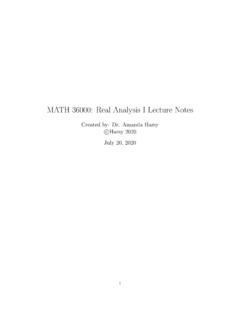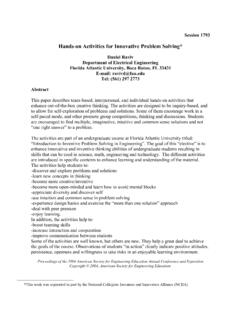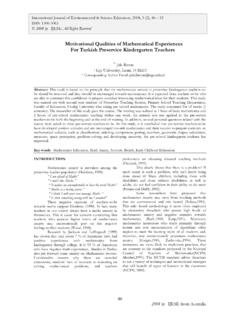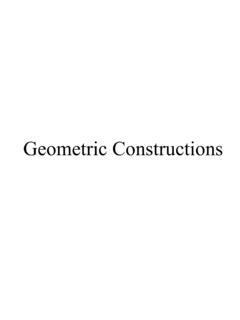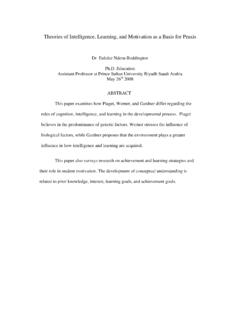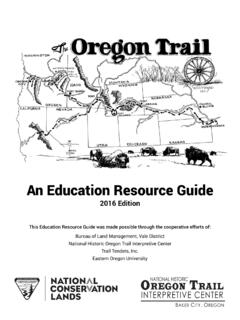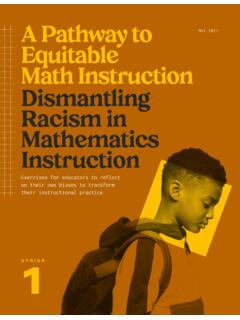Transcription of MATH 36100: Real Analysis II Lecture Notes - Lewis University
1 MATH 36100: Real Analysis II Lecture NotesCreated by: Dr. Amanda HarsyJuly 20, Syllabus Crib Office Hours .. Grades .. Expectations and Norms for the Course .. About the Course ..71 Setting the Stage .. Quick Review .. General Review .. of Sups and Infs (Supremum and Infimums) ..142 Metric Spaces173 Introduction to Cardinality .. Open and Closed Sets .. Sets .. Sets .. Bounded Sets .. Convergent Sequences in Metric Spaces .. Limit Points .. Isolated Points .. Closure .. Interior ..604 Complete Metric Spaces655 Compact Metric Cluster Points ..756 Connected Metric Spaces837 Continuous Properties of Continuous Functions .. Path Connected .. Syllabus Crib NotesThe full syllabus is posted in Blackboard with sample proof rubrics. Here are some highlightsfrom the Office HoursPlease come to my office hours! Helping you with the material is the best part of my job!
2 Ihave 5 weekly office hours which I will hold. My office is inAS-124-A. Remember if noneof these times work, send me an email and we can schedule another time to meet. I can alsoanswer questions through email! This semester my office hours will be:Mondays: 10:30-11:00 Tuesdays: 11:00-12:00 and 1:00-2:00 Wednesdays: 10:30-11:00 Thursdays: 1:00-2:00 Fridays: 2:00-3:00Or By Appointment!Note:Sometimes I have meetings or class that goes right up to my office hours, so if I amnot there, please wait a few minutes. Also sometimes I have unexpected meetings that getscheduled during my office hours. If this happens, I will do my best to let you know as soonas possible and I usually hold replacement office :Don t wait to get help. Visit me during my office hours, use the discussion forum inBlackboard, go to the Math Study Tables, find a study partner, get a tutor!Dr. Harsy s web page:For information on undergraduate research opportunities, aboutthe Lewis Math Major, or about the process to get a Dr.
3 Harsy letter of recommendation,please visit my website: ~ :Check the Blackboard website regularly (at least twice a week) during thesemester for important information, announcements, and resources. It is also where you willfind the course discussion board. Also, check your Lewis email account every day. I will useemail as my primary method of communication outside of office GradesCategoryPercentageHomework60 Productive Engagement20 Portfolio20Dr. Harsy reserves the right to change the percentages of these Engagement:In order to achieve the maximum points for this portion ofyour grade you must actively Present, Facilitate, and Participate in class activities, presentproblems and proofs from homework and ICE sheets, and participate in class Portfolio:You will keep a Proof Portfolio written in a LATEX file. This will be anend of the year project in which I would like you to write up your top/favorite 5 proofsfrom the class. After each proof, give an explanation about why you chose this proof.
4 Theseportfolios will be due thesecond to lastday of class and we will go over your choices alongwith your memes on the last day of class. If you would like a template for this portfolio, letme know and I will put one together for it!Team Homework:We will work through guided Notes and in-class exercises. Each weeka subset of these problems will be assigned as a Team Homework assignment which you canwork on with a group of no more than 4 people. You will have one chance to revise thishomework and for each assignment, you should include A summary of how you worked on this homework as a group and A signed statement stating that everyone contributed to this homework should be submitted as a team and should be written in LATEX unless theproblem requires pictures or there is a good reason to not Tex it Expectations and Norms for the Course1. I will embrace challenges because they help me I will not be afraid of making mistakes and taking risks because they provide I will be respectful of the diversity in the I will be a mindful contributor and work as a team during classroom I will have a positive attitude about this class because my attitude is something I I will be appreciative of the effort others put forth during this I understand that assessment opportunities give me a chance to demonstrate my growthand I will minimize distractions during I will help to create an inclusive learning About the Course If intellectual curiosity, professional pride, and ambition are the dominant incentives toresearch, then assuredly no one has a fairer chance of gratifying them than a subject is the most curious of all-there is none in which truth plays such odd pranks.
5 Ithas the most elaborate and the most fascinating technique, and gives unrivaled openings forthe display of sheer professional skill. Finally, as history proves abundantly, mathematicalachievement, whatever its intrinsic worth, is the most enduring of HardyThanks for taking Real Analysis I with me! Real Analysis is one of my favorite courses toteach. In fact, it was my favorite mathematics course I took as an undergraduate. You maybe wondering, What exactly is Real Analysis ? Analysis is one of the principle areas in mathematics. It provides the theoretical underpin-nings of the calculus you know and love. In your calculus courses, you gained an intuitionabout limits, continuity, differentiability, and integration. Real Analysis is the formalizationof everything we learned in Calculus. This enables you to make use of the examples andintuition from your calculus courses which may help you with your proofs. Throughout thecourse, we will be formally proving and exploring the inner workings of the Real NumberLine (hence the nameRealAnalysis).
6 But Real Analysis is more than just proving calculus,and I think Dr. Carol Schumacher of Kenyan College describes it extremely well by whenshe callsAnalysisthe Mathematics of Closeness. At its core, this is what Real Analysisis above. When you think about the derivatives and integration, remember we talk abouttaking small changes, xwhether it be a y xor a partition for our Riemann Sums. Ourjob in Real Analysis is to understand how to formally describe closeness and the process ofgetting closer and closer (limits).Recall, Real Analysis I started with very abstract concepts and became more concrete as thesemester goes on. Remember, the hardest part of the class is at the beginning! We started bytalking about bounds of real numbers which allows us to prove that there is in fact a uniquelimit we want to reach. We then explored sequences which we will use to get as close as wecan to these numbers/bounds. Next we discussed closeness in a function setting along withcontinuity.
7 We needed continuity later for our integration and special derivative then revisited and use sequences and functions to discuss rate of change (derivatives)and optimization. We wanted to finish with Riemann Sums and the beautiful FundamentalTheorem of really debated with what to do for Real Analysis II and I have decided to take a moreabstract and general approach to the concepts in Real Analysis I. Some Analysis coursesactually do this from the beginning, but at times you will be able to use your intuition fromReal Analysis I to help you with the concepts here. Sometimes you will prove more generalversions of the proofs from Real Analysis I. If we have time, we may add some point-set7topology (maybe).I hope you will enjoy this semester, learn a lot, and feel challenged by the material (in a goodway)! Please make use of my office hours and plan to work hard in this class. My classeshave a high work load (as all math classes usually do!)
8 , so make sure youstay on top ofyour assignments and get help early. Remember you can also email me questions ifyou can t make my office hours or make an appointment outside of office hours for I am at Lewis , I usually keep the door open and feel free to pop in at any time. If Ihave something especially pressing, I may ask you to come back at a different time, but ingeneral, I am usually available. I have worked hard to create this course packet for you, butit is still a work in progress. Please be understanding of the typos I have not caught, andpolitely bring them to my attention so I can fix them for the next time I teach this look forward to meeting you and guiding you through the wonderful course that is RealAnalysis Part 2 Electric ,Dr. HAcknowledgments:No math teacher is who she is without a little help. I would like tothank my own undergraduate professors from Taylor University : Dr. Ken Constantine, Delong, and Dr. Jeremy Case for their wonderful example and ideas for structuringexcellent learning environments.
9 I also want to thank Dr. Annalisa Crannell, Dr. TomClark, Dr. Alyssa Hoofnagel, Dr. Alden Gassert, Dr. Francis Su, Dr. Brian Katz, and Millichap for sharing some of their resources from their own finally,I would like to thank you and all the other students for making this job worthwhile and forall the suggestions and encouragement you have given me over the years to Setting the StageWelcome to the first day of Real Analysis II, before we dive in, I have a small activity forus to set the stage for the method of teaching in this course. First, form into groups of size 2-3. Group members should introduce themselves. For each of the questions below, I would like you to:1. Think about a possible answer on your Discuss your answers with the rest of your Share a summary of each groups discussion (each person will present at least onequestion.)Question 1: What are the goals of a University education?Question 2: How does a person learn something new?
10 9 Question 3: What do you reasonably expect to remember fromyour courses in 20 years?Question 4: What is the value of making mistakes in the learningprocess?Question 5: How do we create a safe environment where risk takingis encouraged and productive failure is valued? Any creative endeavor is built on the ash heap of failure. -Michael Starbird11 University of Texas at Austin Mathematics Quick ReviewWork with your group to come up with a quick recap of what you learned in Real make a list of major concepts and see if you can remember their General Review1. Is Q? Explain why or why Is 0 ? Explain why or why Explain what is wrong with the following notations:N Qand 1 Write in words what the following set means:A={x Q:x2<3}.Dr. Harsy notation comment: I sometimes use | instead of : so in our classA:={x Q:x2<3}={x Q|x2<3}5. Thesymmetric difference of sets A and B, denotedA Bis a set of whoseelements belongs to A but not to B, or belongs to B but not to A.
